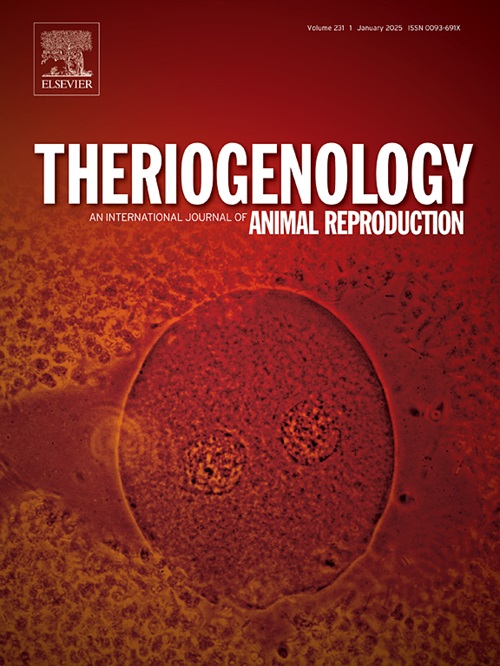Beneficial effects of pentoxifylline on spermatogenesis and germ cell apoptosis in stallions subjected to scrotal heat stress
IF 2.4
2区 农林科学
Q3 REPRODUCTIVE BIOLOGY
引用次数: 0
Abstract
This study evaluated the effects of oral pentoxifylline on testicular biometry, histology, and gene expression in stallions subjected to scrotal heat stress. Fourteen stallions were divided into three groups: Control (CRL, n = 4), Testicular Degeneration (DEG, n = 5), and Testicular Degeneration Treated with Pentoxifylline (DEG + PTX, n = 5). Testicular degeneration was induced by scrotal insulation, twice daily, over two consecutive days (D-1 and D0). Starting the next day (D1), oral pentoxifylline (17 mg/kg) was administered every 12 h for 30 days. Testicular biometry was measured using a caliper from D-5 to D60. On days 30 and 60, testicular biopsies were collected for histopathology and gene expression analysis of BAX, CASP8, CASP9, FAS, HSF1, and PTGS2 using RT-qPCR. Pentoxifylline reduced histological damage, with the DEG + PTX group showing less pronounced basal lamina undulation and seminiferous tubule atrophy compared to the DEG group. However, it did not fully prevent lesions like germ cell vacuolization, which was reflected macroscopically by a reduction in testicular volume in both degenerated groups. The protective effects of pentoxifylline on testicular tissue can be attributed to its ability to reduce BAX expression, prevent CASP8 and CASP9 activation, and promote cellular protective mechanisms through HSF1 activation at D30. These results highlight pentoxifylline’s potential as a therapeutic agent for equine testicular damage due to scrotal heat stress, suggesting the need for further research on optimal dosage and treatment duration.
喷托维林对阴囊热应激下种马精子发生和生殖细胞凋亡的有益影响
本研究评估了口服喷托维林对阴囊热应激下种马睾丸生物测量、组织学和基因表达的影响。14 头种马被分为三组:对照组(CRL,n = 4)、睾丸退化组(DEG,n = 5)和用五氯去氧肾上腺素治疗的睾丸退化组(DEG + PTX,n = 5)。连续两天(D-1 和 D0)通过阴囊保温诱导睾丸退化,每天两次。从第二天(D1)开始,每隔 12 小时口服一次戊唑醇(17 毫克/千克),持续 30 天。从D-5到D-60,使用卡尺测量睾丸生物测量值。第30天和第60天,收集睾丸活检组织病理学,并使用RT-qPCR分析BAX、CASP8、CASP9、FAS、HSF1和PTGS2的基因表达。五氧化锡可减轻组织损伤,与 DEG 组相比,DEG + PTX 组的基底膜起伏和曲细精管萎缩较不明显。然而,它并不能完全防止生殖细胞空泡化等病变,这在宏观上反映为两个退化组的睾丸体积都有所缩小。喷托维林对睾丸组织的保护作用可归因于它能减少 BAX 的表达、阻止 CASP8 和 CASP9 的活化,以及通过在 D30 激活 HSF1 促进细胞保护机制。这些结果凸显了喷托非韦林作为阴囊热应激所致马睾丸损伤治疗剂的潜力,同时也表明需要进一步研究最佳剂量和治疗时间。
本文章由计算机程序翻译,如有差异,请以英文原文为准。
求助全文
约1分钟内获得全文
求助全文
来源期刊

Theriogenology
农林科学-生殖生物学
CiteScore
5.50
自引率
14.30%
发文量
387
审稿时长
72 days
期刊介绍:
Theriogenology provides an international forum for researchers, clinicians, and industry professionals in animal reproductive biology. This acclaimed journal publishes articles on a wide range of topics in reproductive and developmental biology, of domestic mammal, avian, and aquatic species as well as wild species which are the object of veterinary care in research or conservation programs.
 求助内容:
求助内容: 应助结果提醒方式:
应助结果提醒方式:


